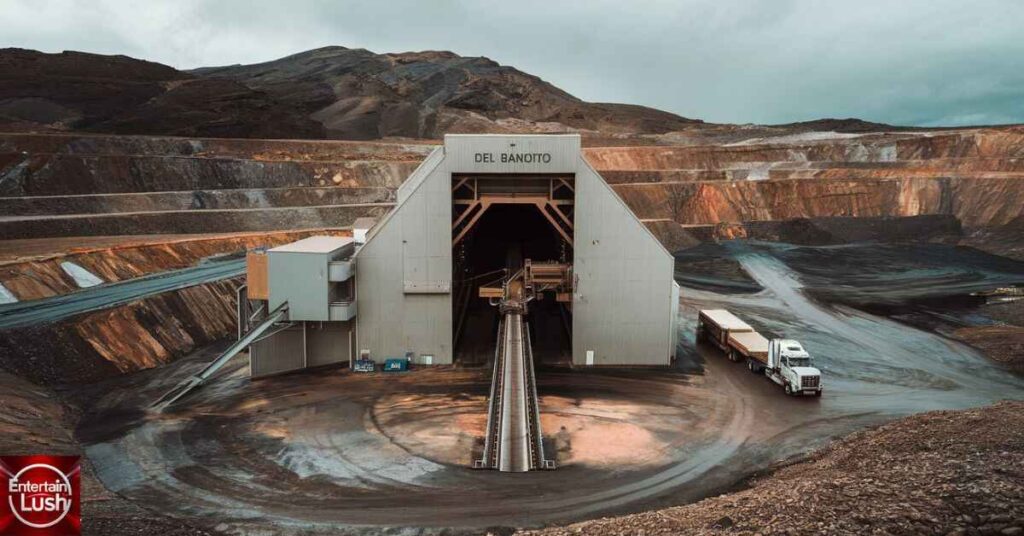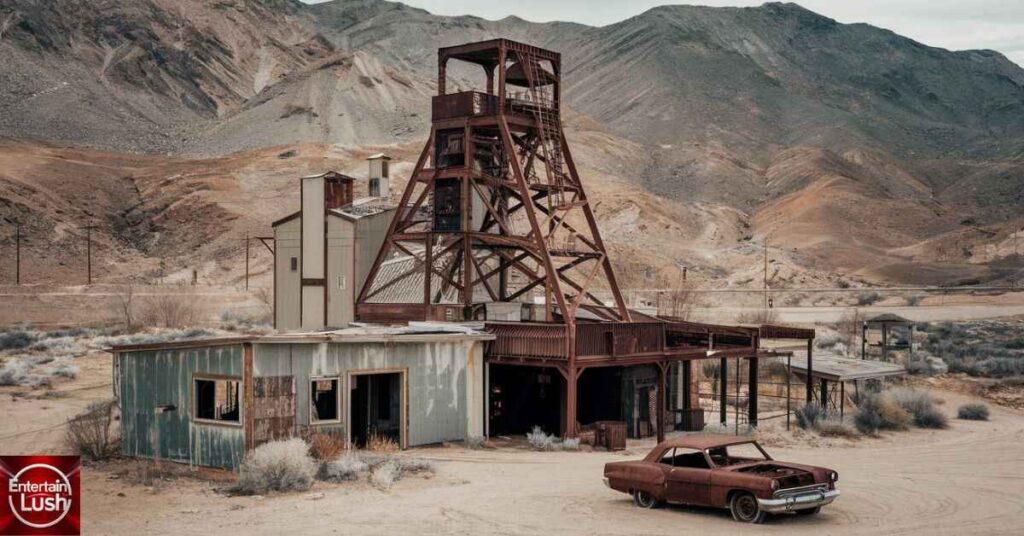Del Bandito Mine in Esmeralda County, Nevada, holds a captivating history often overlooked by modern visitors. This forgotten gem of the American West once bustled with miners seeking their fortunes. Today, its abandoned structures stand as silent witnesses to a bygone era.
Exploring Del Bandito’s past reveals tales of hard work, hope, and heartbreak. This article delves into the mine’s rich history, from its golden heyday to its eventual decline. Discover the stories of those who shaped this remarkable site and learn how it continues to influence Esmeralda County’s identity.
The Birth of Del Bandito Mine
In 1873, prospector John Smith stumbled upon gold-rich quartz veins in Esmeralda County. This chance discovery led to the birth of Del Bandito Mine. Word spread quickly, sparking a small gold rush to the area. Miners flocked to the site, hoping to strike it rich. The mine’s remote location added to its allure, attracting adventurers and fortune-seekers from across the country.
Geological Features of Esmeralda County
Esmeralda County’s unique geology made it a goldmine, literally. The area’s volcanic history created ideal conditions for gold deposits. Mineral-rich veins ran through the quartz rock, promising high yields. The surrounding mountains also contained other valuable minerals. This geological bounty made it a promising venture for early investors and miners alike.
Early Development and Ownership
Del Bandito Mine’s early years were marked by rapid development. The original claim holders sold to a mining company in 1875. This company invested in infrastructure and equipment. They built shafts, tunnels, and processing facilities. By 1880, Del Bandito Mine was fully operational. It employed over 100 miners and support staff. The mine’s ownership changed hands several times in its early decades.
Life in Del Bandito: The Miner’s Experience
Miners at Del Bandito Mine faced harsh conditions daily. They worked long hours in dark, dusty tunnels. The risk of cave-ins and accidents was ever-present. Miners often suffered from lung diseases due to poor air quality. Pay was low, and living conditions were basic. Despite these challenges, many stayed, driven by the hope of striking it rich. The tough life at Del Bandito forged a tight-knit community of resilient workers.
Mining Techniques and Technology
Del Bandito Mine used various techniques to extract gold. In the early years, miners relied on pickaxes and manual labor. As the mine grew, steam-powered drills and lifts were introduced. By 1890, Del Bandito had a stamp mill to crush ore. Cyanide processing improved gold recovery in the early 1900s. These advancements increased efficiency but also brought new dangers to miners.
The Miner’s Community: Life Beyond the Shaft
A vibrant community grew around Del Bandito Mine. Families settled in nearby towns, creating a close-knit society. The mine sponsored social events and festivals. Churches and schools were built to serve the growing population. Saloons and general stores became community hubs. Despite the hardships, residents of its community found ways to enjoy life and support each other.
Economic Impact and Significance

The Role of Del Bandito Mine in Esmeralda’s Economy
The Mine greatly influenced Esmeralda County’s economy. It created numerous jobs and attracted new residents. Local businesses thrived due to increased demand. The mine’s gold production boosted Nevada’s overall mineral output. Tax revenues from Mines funded local infrastructure projects. The economic ripple effect extended beyond the immediate area, contributing to the state’s growth during the late 19th and early 20th centuries.
Peak Production Years
Del Bandito Mine reached its peak production between 1895 and 1905. During this decade, the mine yielded over 500,000 ounces of gold. This output made it one of Nevada’s top producers. The mine employed over 300 workers at its height. Advanced mining techniques and favorable gold prices contributed to this success. Del Bandito Mine’s prosperity during these years left a lasting impact on Esmeralda County’s development.
Supporting Industries and Infrastructure
It spurred the growth of various support industries. Transportation improved with the construction of roads and a small railway. Hotels and boarding houses sprang up to accommodate workers and visitors.
Supply stores, blacksmiths, and assay offices opened to serve the mine’s needs. A telegraph office connected the remote area to the outside world. These developments transformed the once-isolated region into a bustling mining district.
Legends and Lore: Tales of Bandits and Treasure
Del Bandito inspired many colorful stories. One popular tale spoke of a bandit who hid stolen gold in the mine’s tunnels. Another legend claimed a secret chamber held a vast treasure. Miners often shared ghostly encounters in the deep shafts. These stories added to the mine’s mystique and attracted curious visitors. While likely exaggerated, these tales became part of its rich folklore, passed down through generations.
Famous Visitors and Notable Events
It attracted several notable figures. In 1897, future president Herbert Hoover, then a young mining engineer, visited to assess the mine’s potential. Famous prospector Jim Butler toured the site in 1900, shortly before his own major silver discovery. The mine also hosted a memorable Fourth of July celebration in 1901, featuring a brass band and fireworks display. These events added to reputation as a significant site in Nevada’s mining history.
The Origin of the Name “Del Bandito”
The name “Del Bandito Mine” has intriguing origins. Local lore suggests it was named after a Mexican bandit who once hid in the area. Others claim early prospectors chose the name to add mystery and allure. The Spanish words “Del Bandito” mean “of the bandit,” fitting the Wild West image of the region. Whatever its true origin, the name captured public imagination and became synonymous with adventure and hidden riches in Esmeralda County.
The Decline of Del Bandito Mine

Factors Leading to the Mine’s Closure
Mine faced several challenges in the 1920s. Gold reserves began to deplete. Mining costs increased as shafts went deeper. The Great Depression hit, causing gold prices to fluctuate. New safety regulations made operations more expensive. Competition from newer mines also increased. These factors combined to make Mine less profitable. By 1930, the mine’s future looked uncertain.
The Last Days of Operation
Del Bandito Mine’s final years were marked by reduced activity. The workforce shrank to a skeleton crew. Equipment breakdowns became more frequent. In 1935, the last ore was extracted. The mine officially closed its doors in 1936. Workers dismantled and sold off equipment. The once-bustling site fell silent, marking the end of an era for Del Bandito Mine.
Economic Aftermath for Esmeralda County
The closure of Del Bandito hit Esmeralda County hard. Many residents lost their jobs. Local businesses struggled without the mine’s economic input. The population declined as families moved away. The county’s tax revenue dropped significantly. It took years for Esmeralda to diversify its economy and recover from the loss of Mine.
Read This Blog: Understanding Relationship Dynamics: An Exploration of TheWifeVo
Del Bandito Mine in Modern Times
Exploring the Ruins Today
The Mine ruins sit quietly in the Nevada desert. Old wood buildings are falling apart. Rusty metal equipment lies scattered around. Visitors can see old tunnels, but they’re closed off. The site is peaceful and eerie. It’s like stepping back in time to the Old West.
Conservation Efforts and Historical Preservation
Some locals want to save its history. They’re trying to get money to fix up the buildings. A small museum in town has some old tools and photos. But it’s hard to get support for ghost towns. The mine slowly crumbles as people debate what to do.
Safety Concerns and Visitation Guidelines
Del Bandito Mine can be dangerous. Floors might cave in. Old tunnels could collapse. Visitors should be very careful. Stay out of buildings and don’t go in tunnels. Bring water and watch for snakes. There are no official rules, but use common sense. Respect the site and take only pictures.
Cultural Legacy

The Impact of Del Bandito on Local Folklore
It has sparked many local stories. People talk about ghost miners and hidden gold. Some say they hear odd noises at night. Artists paint the mine’s spooky beauty. The mine has become part of the area’s identity. It reminds folks of their tough, resourceful ancestors.
Also Read: Total Apex Sports by Vincent Pensabene: The Key to Unlocking Athletic Potential
Representation in Literature and Media
A few books mention Del Bandito Mine. Local writer Jane Smith wrote a mystery set there in 2018. Some indie filmmakers shot a short horror movie at the site in 2021. But the mine hasn’t hit the big time. It’s mostly known by history buffs and ghost town fans.
Annual Events and Commemorations
Every October, Esmeralda has a small Mine festival. People dress up like old-time miners. There’s a chili cook-off and music. Kids go on pretend “gold hunts.” It’s a fun way to remember the town’s mining past. About 200 people usually show up to celebrate.
Preserving the Legacy of Del Bandito Mine
Del Bandito Mine tells an important story about our past. It shows how people lived and worked long ago. We need to save this history for our kids and grandkids. Old photos, tools, and stories help us understand the miners’ lives. Some folks are working to write down memories before they’re lost. It’s like saving a piece of our community’s soul. Without places like Del Bandito, we might forget where we came from.
Educational Initiatives and Museum Exhibits
The local school takes kids to Del Bandito once a year. They learn about old mining methods and the town’s history. In 2022, the community center set up a small exhibit about the mine. It has old photos and some miner’s tools. Sometimes, former miners come to talk to students. These programs help young people connect with their town’s past. They make history feel real and exciting, not just boring facts in a book.
FAQ
When was Del Bandito Mine discovered?
It was discovered in 1873 by prospector John Smith.
How long was Del Bandito Mine operational?
Del Bandito Mine was operational for about 63 years, from 1873 to 1936.
Is it legal to visit Del Bandito Mine today?
The text doesn’t explicitly state if it’s legal, but it implies visitors can explore the ruins.
What safety precautions should visitors take when exploring Del Bandito Mine?
Visitors should stay out of buildings and tunnels, bring water, and watch for snakes.
Are there any artifacts from Del Bandito Mine on display in local museums?
Yes, a small museum in town has some old tools and photos from Del Bandito Mine.
Conclusion
Del Bandito Mine tells a story of hope and hard work. It was important for Nevada’s growth. The mine started in 1873 and closed in 1936. Today, it’s a quiet place that reminds us of the past. People can visit, but must be careful.
The mine’s story lives on in local events and school trips. It helps us remember the tough miners who came before us. Del Bandito Mine is more than old buildings. It’s a piece of history that connects us to our roots.
Mr. Dravid is the dedicated author of the business category on Entertainlush.com. With a keen eye for industry trends and a passion for insightful analysis, he delivers valuable content that empowers readers to stay ahead in the ever-evolving business landscape. His expertise ensures that every article is both informative and engaging, helping audiences navigate the complexities of the business world.







